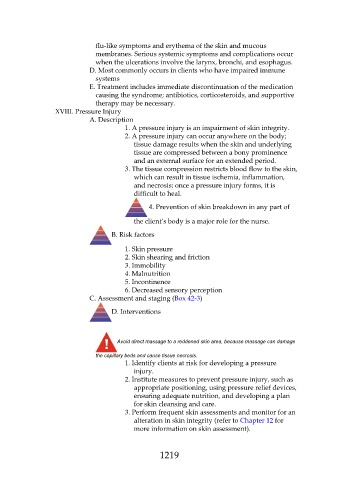Page 1219 - Saunders Comprehensive Review For NCLEX-RN
P. 1219
flu-like symptoms and erythema of the skin and mucous
membranes. Serious systemic symptoms and complications occur
when the ulcerations involve the larynx, bronchi, and esophagus.
D. Most commonly occurs in clients who have impaired immune
systems
E. Treatment includes immediate discontinuation of the medication
causing the syndrome; antibiotics, corticosteroids, and supportive
therapy may be necessary.
XVIII. Pressure Injury
A. Description
1. A pressure injury is an impairment of skin integrity.
2. A pressure injury can occur anywhere on the body;
tissue damage results when the skin and underlying
tissue are compressed between a bony prominence
and an external surface for an extended period.
3. The tissue compression restricts blood flow to the skin,
which can result in tissue ischemia, inflammation,
and necrosis; once a pressure injury forms, it is
difficult to heal.
4. Prevention of skin breakdown in any part of
the client’s body is a major role for the nurse.
B. Risk factors
1. Skin pressure
2. Skin shearing and friction
3. Immobility
4. Malnutrition
5. Incontinence
6. Decreased sensory perception
C. Assessment and staging (Box 42-3)
D. Interventions
Avoid direct massage to a reddened skin area, because massage can damage
the capillary beds and cause tissue necrosis.
1. Identify clients at risk for developing a pressure
injury.
2. Institute measures to prevent pressure injury, such as
appropriate positioning, using pressure relief devices,
ensuring adequate nutrition, and developing a plan
for skin cleansing and care.
3. Perform frequent skin assessments and monitor for an
alteration in skin integrity (refer to Chapter 12 for
more information on skin assessment).
1219

